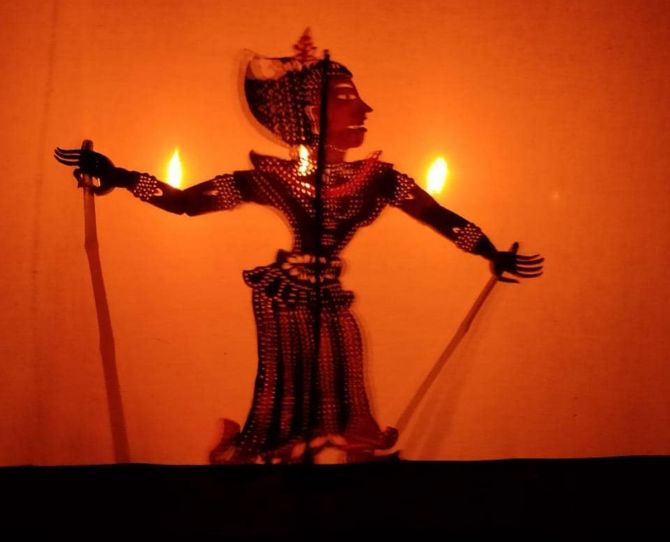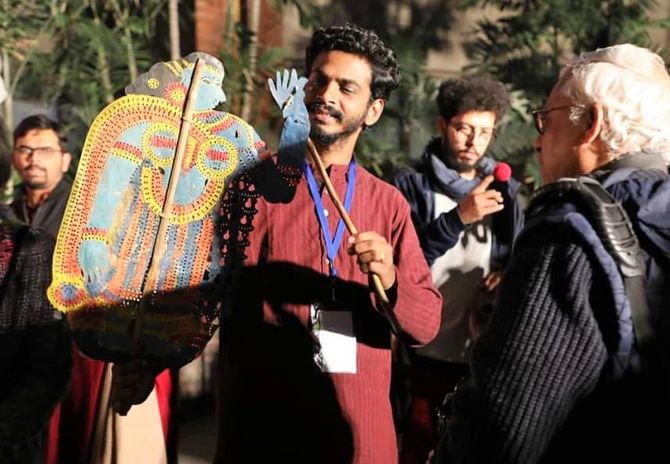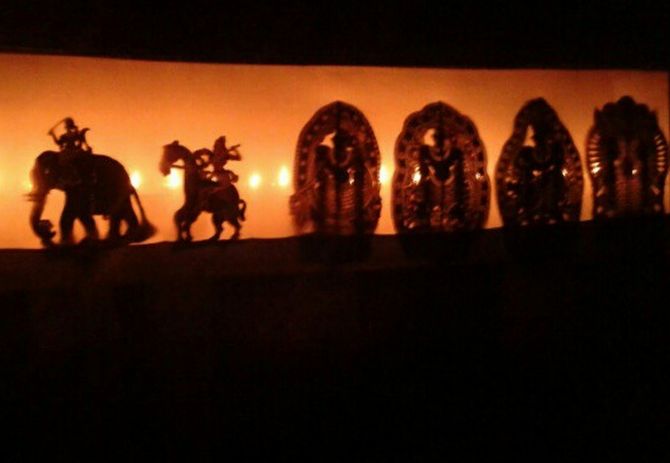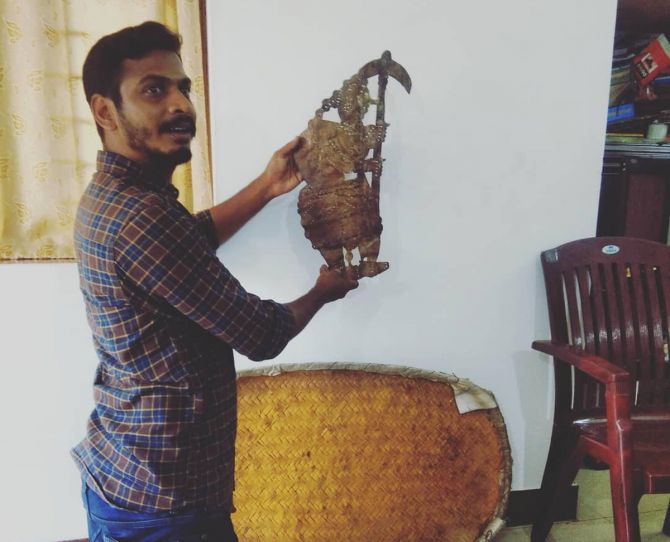The episode of Lord Rama's pursuit to catch the golden deer was selected for the robotic application and a total of four leather puppets -- Lord Rama, Goddess Sitha, Lakshmana and the Deer -- were automated.
Lekshmi Gopalakrishnan/PTI reports.

He grew up watching the ochre shadows and dancing silhouettes of leather puppets popping up on the white cloth-screen at 'koothumadams' (temple theatre).
While learning the maiden lessons of manipulating light from the oil lamps and creating beautiful shadows moving the ritual puppets at these specially erected theaters, never had the teenager imagined that he would once pave the way for animating them with the help of robotics.
For the first time in the centuries-old history of shadow puppetry in the country, the leather puppets recently performed the epic Ramayana with the support of robotics in Kerala and Sajeesh Pulavar, a young puppeteer, was the brain behind the path-breaking initiative.

For Sajeesh, Tholpavakoothu, a form of shadow puppetry prevalent in the state, robotic automation of leather puppets is one of the several diversification attempts for the revival and preservation of the ancient art form from not becoming extinct.
The three-minute performance of the automated puppets, the brainchild of the artist, has been a huge hit among art buffs and common people after it was put on display at the District Heritage Museum here recently.
Traditionally performed in Bhagavathy (Goddess) temples as a ritualistic offering, the art form, believed to be at least 700 years old, is seen in the northern Palakkad and surrounding districts in the southern state and preserved as a tradition by 'Pulavars'.
Pulavar is the title given to a scholar and performer who has extensive knowledge of Tholpavakoothu.
According to mythology, the ritual art was performed following the request of Goddess Bhadrakali who missed watching the triumph of Lord Rama over the ten-headed demon king Ravana as she was engaged in a battle with Darika, an evil character killed by her later.
However, artists like Sajeesh are making all efforts to bring the art form out of the borders of the temples and experiment in different formats to regain audience and attract common people.
Besides the robotic application, Sajeesh, hailing from a traditional Pulavar family, is attempting a host of innovations ranging from presentation of classical poetry and government's awareness programmes to 'save-the-date' wedding invitations in the format of the Tholpavakoothu to preserve it.

A mechanical engineer by profession, 32-year-old Sajeesh said he did not have to think twice to quit his well-paid job in an MNC, while seeing his father and shadow puppetry exponent Lakshmana Pulavar struggling hard to retain the legacy of the family.
Not money, but carrying forward the tradition and legacy of the art form, passed down by the ancestors through generations is more important, the award-winning puppeteer said.
"I belong to the thirteenth generation of the Pulavar community in our family. My younger brother and I grew up seeing our father and grandfather going to one temple after the other to perform puppetry during the season," he tells PTI.
It was the glorious period of the traditional art form but eventually people's interest in it dwindled in the flood of new modes of entertainment and changes in cultural values, he said.
Bringing innovations in the format of Tholpavakoothu is a challenge as it is a ritual art based on the rendering of Ramayana -- the Kamba Ramayana, the Tamil version of the epic, he said.
"As people are doing it as offerings in temples, we can not deviate even an inch from the conventional format at the shrines. But, while performing in stages, we have freedom to experiment. There we will apply all techniques and tricks to make the audience glued to our performance," the artist explains.

The application of robotics was an idea developed solely to catch the attention of the audience and revive their interest in the art form, he said.
"We first thought about automating puppets in 2015. Considering its huge expense, we put the plan on hold then. But, when temples had been closed and programmes cancelled due to the COVID spread, we revived the plan again," says Sajeesh.
When the authorities of the district heritage museum approached Lakshmana Pulavar and Sajeesh Pulavar for their leather puppets to exhibit there, the artists had shared with them the idea of robotic application and manipulating puppets with the help of automation.
As the museum authorities showed keen interest in the initiative and promised to fund the project, Sajeesh approached his friend Rahul P Balachandran, who heads the Thrissur-based Inker Robotics, an emerging startup specialized in robotics and futuristic technologies.
The rest of the days were that of brainstorming and hectic schedules as Sajeesh and the expert team of the company had spent several hours together to code the movements of the puppets and correct it.
"The soul of the Tholpavakoothu is the skilled hand movements of the Pulavar who manipulate the puppets. We can master the skill only through years-long hard work and rigorous practice. That human precision cannot be brought in robotic automation," he explains.

The episode of Lord Rama's pursuit to catch the golden deer was selected for the robotic application and a total of four leather puppets -- Lord Rama, Goddess Sitha, Lakshmana and the Deer -- were automated to be displayed at the museum.
Music and rendition of Ramayana verses, which was usually live during the performance, were recorded and an LED display, giving glimpses of the brief history of Tholpavakoothu, was arranged as part of the exhibition.
"Variety of our leather puppets are put on display in museums across the country. But, it is for the first time that a robotic puppet of ours is exhibited in a museum. Even those who have no knowledge about Tholpavakoothu, are talking about it now. It is just a three minute-performance. But its impact is immense," he says.
However, the artist is very much conscious that technology has its own limitations and robotics cannot be taken to the temple grounds during the time of live performances.
"We can never ever bring the entire Tholpavakoothu in the format of robotics. It is a 21-day performance lasting a total of 210 hours involving over 180 puppets. It is impossible to automate the complete performance."
But, Sajesh says they were getting queries to exhibit similar robotic puppets in other museums also.

A query was received from the authorities of Nedumbassery airport also for the same, he adds.
As part of diversification initiatives, his team recently did the adaptation o Poothapattu, the iconic poetry by Edasseri Govindan Nair, in the format of shadow puppetry.
The awareness videos, done in connection with the election commission's Systematic Voters' Education and Electoral Participation programme and the COVID pandemic for the district administration, were also a huge hit.
Besides carrying out stage shows, online classes, demonstrations and workshops, the young practitioner also travels across the country to learn various indigenous forms of puppetry and puppet making as part of a mission to revive the dying art form.
A recipient of several awards and fellowships including the Yuva Prathiba award (folklore) of the state government in 2020, Sajeesh has staged hundreds of programmes in the country and abroad during his 22-year-long association with the art form.
His brother, Sajeev Pulavar, a mechanical engineering diploma holder, is also a Tholpavakoothu practitioner.
Feature Presentation: Rajesh Alva/Rediff.com










